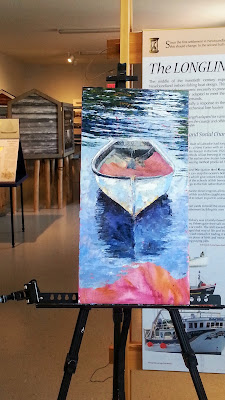Drifter - SOLD
12" x 24"
oil on panel, framed
On July 16th, I spent the afternoon painting at the Wooden Boat Museum of Newfoundland and Labrador. With my connection to boats, what better place to demonstrate a boat painting than this museum and I was delighted to accept their invitation for the 3rd year. Surrounded by traditional, hand built wooden boats of all kinds, I swear the atmosphere helps the painting flow.
Painting progress shots at the museum
I chose this little punt to demonstrate with a palette knife and, between conversations with visitors, had about three quarters of it laid in by the end of the afternoon and added finishing layers and details in my studio. Painting in public is a great way to talk about your work and share some of the techniques and process. I brought a couple of finished paintings so people could see them and their texture close up. Impressionism is a unique technique that really shows its impact when viewed from 8 - 10 feet away, an appropriate viewing distance for most paintings. Up close, the painting becomes almost abstract with sections of colour laid down one against the other in a mosaic that magically comes together when you step back.
Painting in public, for me, doesn't hold a fear factor. In fact, I love explaining the process to people, and even letting them try their hand at palette knife painting. People are genuinely interested and I find that if you are engaged with your work and comfortable with your medium, that comfort level translates into trust and approachability and wins out over any sense of discomfort that could arise.
Yes, of course, interruptions can disrupt the flow of painting, but those breaks are welcome, not intrusive in this situation. I can see if I was working in the open air and had a definite goal in mind for a painting, a string of questions could be frustrating, but in this situation, I see my role as that of educator and demonstrator.
If you've never tried working in public, do. People are a lot more interested and supportive than you think they will be. And its a great way to show your work to the world.






